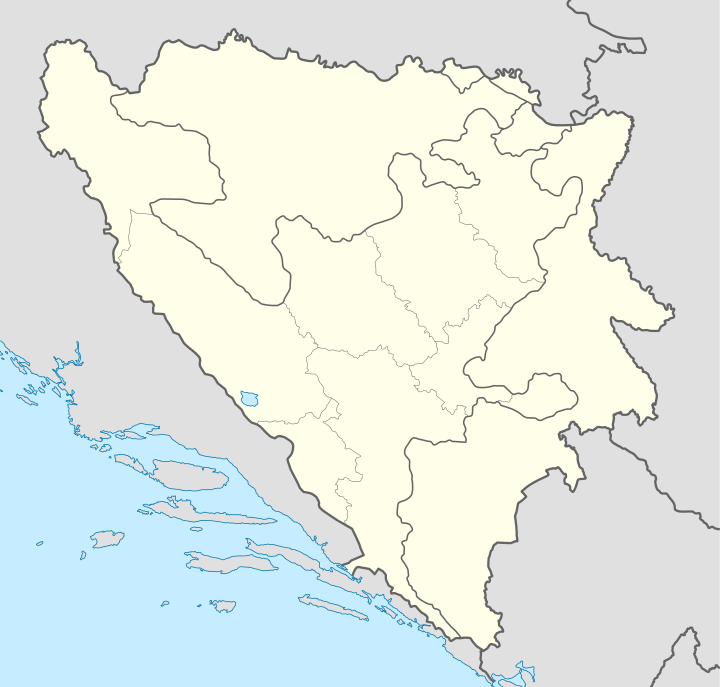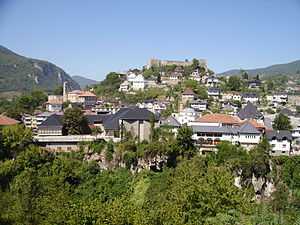Jajce
| Jajce Јајце | ||
|---|---|---|
|
Jajce Waterfall | ||
| ||
 | ||
 Jajce Location of Jajce in Bosnia and Herzegovina | ||
| Coordinates: 44°20′30″N 17°16′10″E / 44.34167°N 17.26944°ECoordinates: 44°20′30″N 17°16′10″E / 44.34167°N 17.26944°E | ||
| Country | Bosnia and Herzegovina | |
| Government | ||
| • Municipality president | Edin Hozan (SDA) | |
| Area[1] | ||
| • Total | 339 km2 (131 sq mi) | |
| Population (2013 census)[2] | ||
| • Total | 30,758 | |
| • Density | 91/km2 (240/sq mi) | |
| Time zone | CET (UTC+1) | |
| • Summer (DST) | CEST (UTC+2) | |
| Area code(s) | +387 30 | |
| Website | http://www.opcina-jajce.ba | |
Jajce is a city and municipality located in the central part of Bosnia and Herzegovina, in the Bosanska Krajina region. It is part of the Central Bosnia Canton of the Federation of Bosnia and Herzegovina entity. It is on the crossroads between Banja Luka, Mrkonjić Grad and Donji Vakuf, on the confluence of the rivers Pliva and Vrbas.
History


Jajce was first built in the 14th century and served as the capital of the independent Kingdom of Bosnia during its time. The town has gates as fortifications, as well as a castle with walls which lead to the various gates around the town. Skenderbeg Mihajlović besieged Jajce in 1501, but without success because he was defeated by Ivaniš Korvin assisted by Zrinski, Frankopan, Karlović and Cubor.[3] When the Bosnian kingdom fell to the Ottoman Empire in 1463, Jajce was taken by the Ottomans but was retaken next year by Hungarian King Matthias Corvinus. About 10–20 kilometres from Jajce lies the Komotin Castle and town area which is older but smaller than Jajce. It is believed the town of Jajce was previously Komotin but was moved after the Black Death.
During this period, Queen Catherine restored the Saint Mary's Church in Jajce, today the oldest church in town. Eventually, in 1527, Jajce became the last Bosnian town to fall to Ottoman rule.[4] There are several churches and mosques built in different times during different rules, making Jajce a rather diverse town in this aspect.
The Franciscan monastery of Saint Luke was completed in 1885.
From 1929 to 1941, Jajce was part of the Vrbas Banovina of the Kingdom of Yugoslavia.
On 29 November 1943, during the Second World War, Jajce hosted the second convention of the Anti-Fascist Council of National Liberation of Yugoslavia, where Tito set up a provisional government and formally deprived the government in exile of its rights, the foundation for the post-war Socialist Federal Republic of Yugoslavia.
At the beginning of the Bosnian War, Jajce was inhabited by people from all ethnic groups, and was situated at a junction between areas of Serb majority to the north, Bosnian Muslim majority areas to the south-east and Croatian majority areas to the south-west.
Bosnian war
At the end of April and the beginning of May 1992, almost all Serbs left the city and fled to territory under the Republika Srpska control. In the summer of 1992, the Army of Republika Srpska (VRS) started heavy bombardment of the city. The Serbian Orthodox Church (Crkva Uspenja Presvete Bogorodice) was blown up in the night between 10 and 11 October 1992.[5] Serb forces entered Jajce on 29 October 1992, apparently due to lack of cooperation between the Bosnian government and Croat forces. The Bosniak and Croat population escaped through Divičani into Travnik. In 1995 Jajce was recaptured during Operation Mistral 2 by the HVO. A significant portion of Serb refugees settled in Brčko while the rest settled in Mrkonjić Grad, Šipovo, and Banja Luka.[6] Jajce became part of the Federation of Bosnia and Herzegovina according to the Dayton Agreement.
Settlements
- Bare
- Barevo
- Bavar
- Biokovina
- Bistrica
- Borci
- Božikovac
- Bravnice
- Brvanci
- Bučići
- Bulići
- Carevo Polje
- Cvitović
- Čerkazovići
- Ćusine
- Divičani
- Dogani
- Donji Bešpelj
- Doribaba
- Drenov Do
- Dubrave
- Đumezlije
- Gornji Bešpelj
- Grabanta
- Grdovo
- Ipota
- Jajce
- Jezero
- Kamenice
- Karići
- Kasumi
- Klimenta
- Kokići
- Kovačevac
- Krezluk
- Kruščica
- Kuprešani
- Lendići
- Lučina
- Lupnica
- Ljoljići
- Magarovci
- Mile
- Peratovci
- Perućica
- Podlipci
- Podmilačje
- Prisoje
- Prudi
- Pšenik
- Rika
- Selište
- Seoci
- Smionica
- Stare Kuće
- Šerići
- Šibenica
- Vinac
- Vrbica
- Vukićevci
- Zastinje
- Zdaljevac
- Žaovine
Demographics
In 1931 today's municipality of Jajce was part of the much bigger Jajce county (together with today's municipalities of Jezero, Dobretići and Šipovo).
| Ethnic Composition | |||||||||||||
| Year | Serb | % | Bosniaks | % | Croats | % | Yugoslavs | % | Others | % | Total | ||
|---|---|---|---|---|---|---|---|---|---|---|---|---|---|
| 1931 | 24,176 | 49.84% | 14,205 | 29.28% | 10,080 | 20.78% | - | - | - | - | 48,510 | ||
| 1961 | 8,670 | 25.14% | 7,545 | 21.88% | 13,733 | 39.82% | 4,342 | 12.59% | 198 | 0.57 | 34,488 | ||
| 1971 | 8,132 | 23.23% | 14,001 | 40.00% | 12,376 | 35.35% | 208 | 0.59% | 285 | 0.83% | 35,002 | ||
| 1981 | 7,954 | 19.31% | 15,145 | 36.76% | 14,418 | 35.00% | 3,177 | 7.71% | 503 | 1.22% | 41,197 | ||
| 1991 | 8,663 | 19.24% | 17,380 | 38.61% | 15,811 | 35.13% | 2,496 | 5.54% | 657 | 1.48% | 45,007 [7] | ||
365 Serbs from Jajce are documented to be killed in Jasenovac concentration camp.[8]
1991
In the town itself, there was 13,579 people, with distribution by ethnic groups:
- Bosniaks - 5,277 (38.86%)
- Bosnian Serbs - 3,797 (27.96%)
- Yugoslavs - 2,217 (16.32%)
- Bosnian Croats - 1,899 (13.98%)
- others and unknown - 389 (2.88%)
1995
According to the Dayton agreement, municipality borders were changed, and included some villages with the Bosnian Croat majority before the war (Mrkonjić Grad and Kneževo municipalities) and excluded some villages with the Bosnian Serb or Bosniak majority before the war.
Jajce today
The economy of the Jajce municipality is nowadays weak. UNESCO has started to renovate the historical parts of the city together with Kulturarv utan gränser, a Swedish organisation (Cultural Heritage without Borders). The main project of the company was to renovate the old traditional houses which symbolised the panoramic view of the city and the waterfall. As of 2006, most of the houses were rebuilt.
In elections of 2008 Bosniak parties won majority in Jajce municipality.[9]
Surroundings
The town is famous for its beautiful waterfall where the Pliva River meets the river Vrbas. It was thirty meters high, but during the Bosnian war, the area was flooded and the waterfall is now 20 meters high. The flooding may have been due to an earthquake and/or attacks on the hydroelectric power plant further up the river.
The historical and cultural richness of Jajce and its municipality is attested by the presence of 24 national monuments : the fortification sistem; "Burić"'s house; orthodox church "Presvete Bogorodice"; "Saint John" church in Podmilačje; the church of "Sv. Marija" with "Sv. Luka"'s tower bell; women's mosque; AVNOJ Museum; "Esma Sultanija"'s mosque; "Kraljev grob" (royal grave) in Zastinje; Jajce, and its ancient district; "Katakombe" and the underground church; "Kapetanović"'s house; "Kršlak"'s house; temple of the God "Mithra"; "Musafirhana"; necropolis with "stećci" in Vinac; "Omer-bey"'s house; the watermills complex on the Pliva's Lakes; Roman Catholic cemetery; "Sarač" house, the financial building, and the first elementary school; "Sinan-bey"'s mosque; "Hadžihafizadić"'s fountain; the fortress in Vinac; the fortress of Jajce. Jajce also lies near Pliva lake and the rivers Pliva and Vrbas flow through the city. Jajce has a rich history and many remains of old times like the St Luke church and the fortress. Jajce was always known for its rich history but it was in the year 2006 that the city was first nominated to be listed as a UNESCO heritage site.
Jajce is situated in the mountains, there is a beautiful countryside near the city, rivers such as the Vrbas and Pliva, lakes like Pliva lake, which is also a popular destination for the local people and some tourists. This lake is called Brana in the local parlance. Not far from Jajce there are mountains that are over two thousand meters high like Vlasic near the city of Travnik. Travelling through the mountain roads to the city may not sit well with some visitors, because the roads are in poor condition, but the scenery is picturesque.
Fishing is very popular on the Pliva lake and river. A part of the sixteenth FIPS-Mouche European Fly Fishing Championship was held on the lake.
Twin towns
References
- ↑ "Osnovne informacije o kantonu". Služba za statistiku za područje Srednjobosanskog kantona u Travniku. Retrieved 2007-10-11.
- ↑ Estimation of the population of the Federation Bosnia and Herzegovina, june 30, 2007 (PDF), Federalni zavod za statistiku, 2007-06-30, retrieved 2007-10-11
- ↑ Enciclopedia Croatica (in Croatian) (III ed.). Zagrem: Naklada Hrvatskog Izdavalačkog Bibliografskog Zavoda. 1942. p. 157. Retrieved March 15, 2011.
- ↑ Pinson, Mark (1996) [1993]. The Muslims of Bosnia-Herzegovina, the Historic Development from Middle Ages to the Dissolution of Yugoslavia (Second ed.). United States of America: President and Fellows of Harvard College. p. 11. ISBN 0-932885-12-8. Retrieved 2012-05-06.
[...] in Bosnia Jajce under Hungarian garrison actually held until 1527
- ↑ http://www.spc.rs/Genocid/Banjalucka/banjaluckal.html
- ↑ A Tale of Two Cities: Return of Displaced Persons to Jajce and Travnik (PDF) (Report) (38). International Crisis Group. 3 June 1998. pp. 2–7.
- ↑ "Stanovništvo prema općinama po mjesnim zajednicama po nacionalnoj pripadnosti". Federation of Bosnia and Herzegovina:Federal Bureau of statistics. 2006-03-17. Archived from the original on 2007-09-25. Retrieved 2007-10-11.
- ↑ https://cp13.heritagewebdesign.com/~lituchy/victim_search.php?field=origin&searchtype=contains&data=Jajce&submit=Go
- ↑ Results, Izbori.ba
External links
- Everything about Jajce(Bosnian)(Croatian)
- Image of Town and Waterfall
- Official Website(Bosnian)(Croatian)
- Tourism in Jajce(Bosnian)(English) (Italian)(German)
- Agency for Cultural, Historical and Natural Heritage and Development of Tourist Potential of Town Jajce(Bosnian)(Croatian)(English)
- Tragovima bosanskog kraljevstva - Tourist route for medieval Bosnia (English)
- Trail of the Bosnian Kingdom - Cultural Tourism in Jajce
- Jajce Tours by Sarajevo Funky Tours - Jajce Tours (Bosnia and Herzegovina)
| ||||||||
| Wikimedia Commons has media related to Jajce. |

